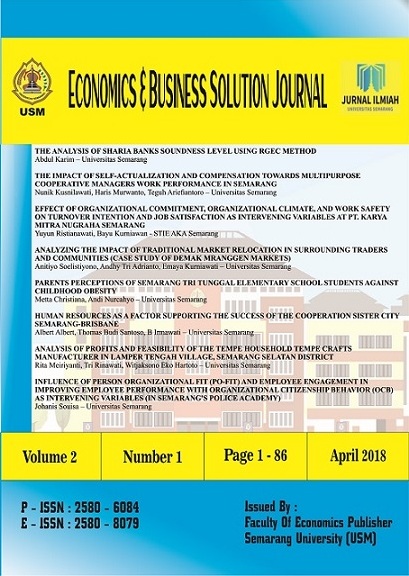The Analysis Of Sharia Banks Soundness Level Using RGEC Method
DOI:
https://doi.org/10.26623/ebsj.v2i1.939Keywords:
RGEC, NPF, ROA, NOM, BOPO, LDR, GCGAbstract
The results of the RGEC method research with the Islamic bank financial statements as an intervening variable show that it is on the NPF ratio seen from the Risk profile. This percentage shows that the total problem financing banks do not exist, the total of 11 Islamic banks show good NPF performance results. The highest value is in Victoria sharia bank 4.75% in 2014 and the lowest is in Bca sharia bank 0.1 in 2014. Meanwhile there are several banks that do not include the NPF results in their financial statements. When referring to the provisions of the Indonesian bank which states that the NPF ideal standard is <5%, the performance of the Sharia Banks is in ideal condition. In the implementation of eleven Sharia Banks GCG, not all report the value of GCG at their annual report. In general it can be said that based on the results of self-assessment on the implementation of Good Corporate Governance in 2010 to 2014, the bank received good and very good predicate, although there is difference in value weight of 0.05.
The earning was measured by ROA ratio, the highest ROA ratio was Sharia Maybank Bank with 4.8% in 2010 and the lowest was 0.35 of Sharia BRI, then in 2012 Sharia Victoria was 6.93 and the lowest was 0.52 of Sharia Bukopin. In 2013 to 2014 ROA of a number of Sharia banks were still at reasonable or stable level.
The Capital was measured by their CAR during 2010 2014. The percentage of CAR shows that the CAR value was ideal. If it refers to Indonesian Bank provisions regarding minimum capital adequacy requirements (CAR), the best standard or minimum CAR was 8% in ideal condition because it had CAR value exceeding the BI standard provisions.
Keywords: RGEC, NPF, ROA, NOM, BOPO, LDR, GCG
References
Alfajar, Muhammad Rasyad. 2014. Analisis Kinerja Keuangan Bank Syariah Devisa dan Bank Syariah Non Devisa Dengan Metode RGEC. Jurnal Mahasiswa UIN Sunan Kalijaga.
Antonio, Muhammad Syafi i. 2005. BankSyariah: Dari Teori Ke Praktik. Jakarta: Gema Insani Press.
Almilia, L. S. and W. Herdiningtyas. (2005). Analisis Rasio Camel Terhadap Resiko Bermasalah pada Lembaga Perbankan Periode 2000-2002. Jurnal Akuntansi dan Keuangan Vol. 7 No. 2 November 2005
Bank Indonesia 2008. Peraturan Bank Indonesia No. 10/15/PBI/2008 tanggal 24 September 2008 tentang Kewajiban Modal Minimum Bank Umum.
Dendawijaya, L. 2009. Manajemen Perbankan. Edisi Kedua. Jakarta: Ghalia Indonesia.
Hanafi, Mamduh dan Abdul Halim 2005. Analisis Laporan Keuangan, Penerbit UPP AMP Yogyakarta
Kasmir (2012: 12) Manajemen Perbankan. Edisi Revisi. Penerbit PT. Raja Pers. Jakarta.
Lestari, Maharani Ika and Toto Sugiharto. 2007. Kinerja Bank Devisa Dan Bank Non Devisa Dan Faktor-Faktor Yang Mempengaruhinya. Proceeding PESAT (Psikologi, Ekonomi, Sastra, Arsitek & Sipil). 21-22 Agustus, Vol. 2. Fakultas Ekonomi, Universitas Gunadarma.
Munawir, 2001. Akuntansi Keuangan dan Manajemen, Edisi Pertama, BPFE, Yogyakarta.
Tarmidzi Achmad dan Willyanto Kartiko Kusumo (2003), Analisis Rasio Keuangan Sebagai Indikator Dalam Memproteksi Potensi Kondisi Bermasalah Perbankan di Indonesia, Media Ekonomi dan Bisnis Vol. XV No. 1, Juni 2003
Downloads
Published
Issue
Section
License
The journal holds the copyright for each article published with work licensed simultaneously under a Creative Commons Attribution 4.0 International License, which allows others to share the work with an acknowledgment of the authorship and early publication of the work in this journal.







